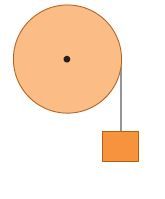Question
A thin, light wire is wrapped
around the rim of a wheel (Fig.). The
wheel rotates without friction about a stationary
horizontal axis that passes through the center
of the wheel. The wheel is a uniform disk
with radius R = 0.280 m. An object of mass
m = 4.20 kg is suspended from the free end of
the wire. The system is released from rest and
the suspended object descends with constant acceleration.
If the suspended object moves downward
a distance of 3.00 m in 2.00 s, what is the
mass of the wheel?

Expert Solution
This question has been solved!
Explore an expertly crafted, step-by-step solution for a thorough understanding of key concepts.
This is a popular solution
Trending nowThis is a popular solution!
Step by stepSolved in 3 steps

Knowledge Booster
Similar questions
- A 1.90 kg mass is attached to a light cord that is wrapped around a pulley of radius 7.25 cm, which turns with negligible friction. The mass falls at a constant acceleration of 2.05m/s2. Find the moment of inertia of the pulley.arrow_forwardAn Atwood machine is constructed using twowheels (with the masses concentrated at therims). The left wheel has a mass of 2 kg andradius 23.1 cm. The right wheel has a mass of2.1 kg and radius 30.77 cm. The hanging masson the left is 2 kg and on the right 1.69 kg.m3m1m4m2What is the acceleration of the hangingmass on the left? Use down as the positive direction. The acceleration of gravity is9.8 m/s2.Answer in units of m/s2.arrow_forwardIn the figure below, block 2 of mass m2 = 3.75 kg rests on a frictionless surface. It is attached to mass 1 (m1 = 2.50 kg) by a massless, stretchless string that passes over a frictionless pulley of radius R = 15.0 cm. When released from rest, block 2 moves to the right with an acceleration of 3.80 m/s2. What is the mass of the pulley? must draw FBDsarrow_forward
- A cord is wrapped around the rim of a wheel 0.300 m in radius, and a steady pull of 38.5 NN is exerted on the cord. The wheel is mounted on frictionless bearings on a horizontal shaft through its center. The moment of inertia of the wheel about this shaft is 5.35 kg⋅m2 Compute the angular acceleration of the wheel.arrow_forwardA block of mass 2 kg slides down an inclined plane at an angle of 45° with a massless tether attached to a pulley with mass 3 kg and radius 0.7 m at the top of the incline (see the following figure). The pulley can be approximated as a disk. The coefficient of kinetic friction on the plane is 0.2. What is the acceleration of the block (in m/s²)? (Enter the magnitude.) 3.59 45° x m/s²arrow_forwardFour particles, each of mass,0.20 kg, are placed at the vertices of asquare with sides of length 0.50 m.Theparticles are connected by rods of negligiblemass. This rigid body can rotatein a vertical plane about a horizontalaxis A that passes through one of theparticles. The body is released fromrest with rod AB horizontal .(a) What is the rotational inertia of thebody about axis A? (b) What is the angularspeed of the body about axis Awhen rod AB swings through the verticalposition?arrow_forward
- You have a grindstone (a disk) that is 90.0 kg, has a 0.340-m radius,and is turning at 90.0 rpm, and you press a steel axe against it with aradial force of 20.0 N. (a) Assuming the kinetic coefficient of frictionbetween steel and stone is 0.20, calculate the angular acceleration ofthe grindstone. (b) How many turns will the stone make before comingto rest?arrow_forwardLet’s approximate the motion of a yo-yo with that of a solid cylinder with a string wrapped around it. The string has alength of 1.2 m and the cylinder has a mass of 0.1 kg and a radius of 0.05 m. Suppose the cylinder was released atrest from the top, what would be its velocity when it reaches the bottom?arrow_forwardA half-Atwood machine is made from a 2 kg box resting on a friction-less ramp (inclined 10 ̋above the horizontal) and a 1.5 kg box hangingfrom the other end of the string. The pulley is a disc with radius 20 cmand mass 1 kg. The system is released from rest.Determine the direction and magnitude of the hanging box’s acceleration.arrow_forward
- In a popular amusement park ride, a rotating cylinder of radius R = 3.10 m is set in rotation at an angular speed of 5.30 rad/s, The floor then drops away, leaving the riders suspended against the wall in a vertical position. What minimum coefficient of friction between a rider's clothing and the wall is needed to keep the rider from slipping?arrow_forwardThe string is massless. The pulley turns on frictionless bearings. Moment of Inertia of the pulley about its axis is 0.0125 kg.m2, its radiusR= 10.0 cm. The mass m1= 5.00 kg, and the mass m2= 4.00 kg. The system is released from rest. Find (a) the acceleration of m1 and (b) the tensions, T1& T2, in the horizontal and vertical portions of the string. The horizontal surface below m1 is smooth.arrow_forward
arrow_back_ios
arrow_forward_ios